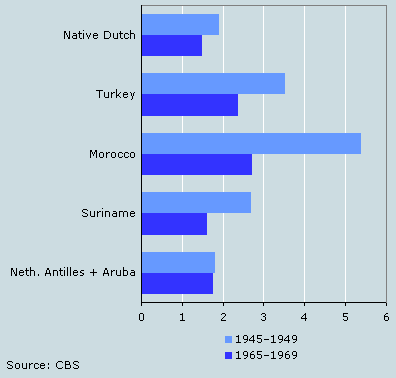Fewer children for second generation women with a foreign background

Non-western foreign women are having fewer and fewer children. Second generation women now give birth to nearly the same number as native Dutch women.
Sharp drop in children of Moroccan mothers
The number of children Moroccan and Turkish mothers in particular are having has dropped sharply in the last few decades. The realised fertility of first generationMoroccan women born in the period 1965–1969 was 2.7 children on average. This is only half the rate for women born twenty years earlier. The rate for all first generation non-western women was considerably higher than the rate for native Dutch women in the same age group. First generation Turkish and Moroccan women in the Netherlands even had more children than their peers in Turkey and Morocco.
Realised fertility of native Dutch women by mother’s year of birth, 1 January 2005

Difference decreasing further
The fertility rate of second generation women with a foreign background hardly differs from that of native Dutch women. They resemble Dutch women more than they resemble their own mothers in this respect. Realised fertility of second generation Surinamese women aged over 30 years, for example, is lower than that of native Dutch women. The rate for second generation Turkish and Moroccan women is around the level of native Dutch women, and clearly below the level of first generation women.
Realised fertility of 30 year-old Moroccan women by mother’s year of birth, 1 January 2005

Second generation women also later mothers
Native Dutch mothers have been the oldest mothers in the world for quite a time now. In 2004 they were on average nearly 30 years old when they had their first baby, 0.6 of a year older than in 1996. Women with a foreign background, too, and especially the second generation are having their first child at increasingly older ages. Second generation Antillean/Aruban women even have their first child at an older age than Dutch women, but the average ages at first-time motherhood of Turkish, Moroccan and Surinamese women hardly differ any more from that of native Dutch women.
Average age of mother at birth of first child

Second generation more likely to remain childless
Second generation women with a foreign background are differing more and more from their mothers as far as fertility and late motherhood is concerned. The share of second generation women who will not have any children at all is also higher than in the first generation. Second generation Turkish, Moroccan, Surinamese and Antillean women are even more likely to be childless at the age of 35 than native Dutch women.
Percentage of 35 year-old women who are childless, 1 January 2005
